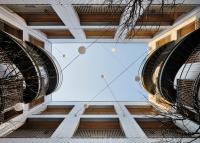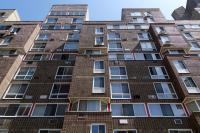Shangsian Cottage
Huzhou, China
Located on the west shore of Taihu Lake, shangsi’an village is flown through by Si’antang creek. A historic stone bridge connects two sides of creek. There is a significant public space near the bridge, which consists of evergreen trees and existed pavilions.
Six buildings scattered throughout the village, were chosen by the client in order to be transformed into a distributed country hotel. Among these six buildings, there is a traditional style exhibition hall near by bridge. Due to its unique location, we transformed it into a public living space for the entire hotel, where serves as a teahouse and library opened to both guests and villagers. Other buildings including a timber house from late Qing dynasty, a warehouse, as well as three two-story buildings with tile facade has been converted into hotel rooms.
Without new walls, these buildings stand with original local paths and yards, only some hints on pavement. In this case, villagers might pass through the hotel area in their daily life. We try to answer questions with the buildings’ distinguishing situation. For example, we redesigned unsteady buildings after demolition, adjusted the tile facade buildings’ functions and relink them to landscape, simply strengthened the timber house. Moreover, in front of the small exhibition hall located, the urban-flavor granite stairs has been replaced by grassy slope. We also constructed an outdoor space by setting up light pavilion, so that both villagers and guests can stay and chat there, feeling the natural breath surrounded by creek.
- Architects
- genarchitects
- Localització
- Changxing County, Huzhou, China
- Any
- 2016
- Equip
- Fan Beilei, Kong Rui, Xue Zhe, Zhang Xun, Chen Xiaoyi, Luo Yiqian, Liu Yang, Tao Shuting, Lei Huanlingzi
- Structura consultant
- Zhang Zhun



















